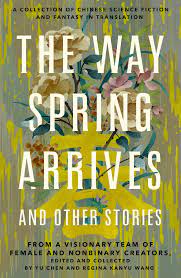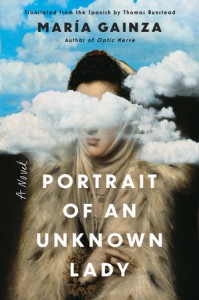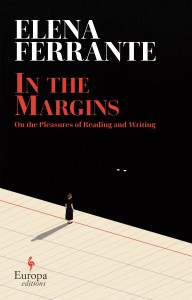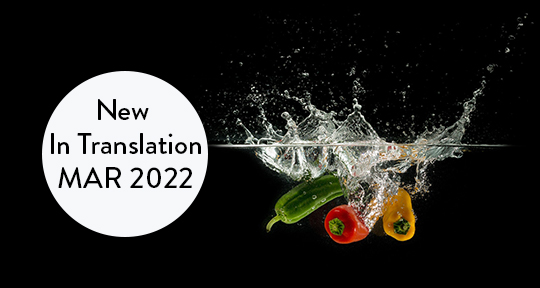March feels like a month of renewal, and our selections of translated literatures this week presents a wondrous and wide-ranging array of original thinking, ideations, philosophies, and poetics. From a revelatory collection of Chinese science fiction, to art critic María Gainza’s novel of forgery and authenticity, to Elena Ferrante’s new collection of essays on writing, and a debut collection of poetry from Iranian-Swedish poet Iman Mohammed—there is no shortage of discovery amidst these texts. Read on to find out more!

The Way Spring Arrives and Other Stories, edited and collected by Yu Chen and Regina Kanyu Wang, Tordotcom Publishing, 2022
Review by Ah-reum Han
The Way Spring Arrives and Other Stories is a trailblazing new anthology of Chinese science fiction and fantasy, created by and featuring the works of an all-female and nonbinary team of writers, editors, and translators. As a lifelong fan of the science fiction and fantasy genre but new to contemporary Chinese literary scene, I found this collection a true gift—warm and generous to the novice like myself, for whom Chinese literature has only ever been accessible through translation. Under the meticulous curatorial vision of Yu Chen and Regina Kanyu Wang, the stories and essays within celebrate decorated and emerging voices alike, indicating at an exciting future of sci-fi and fantasy for digital natives in our culturally porous world.
As you enter the collection, leave everything at the door and hold on tight. This book will whisk you away from one uncanny valley to the next—from a world where children raise baby stars as pets, to a near future where parenting is turned into a computer game, to a fisherman’s village where they practice the art of dragonslaying, to a woman on the road mysteriously burdened with a corpse, and much more. The title story, “The Way Spring Arrives” by Wang Nuonuo (trans. Rebecca F. Kuang), situates itself amidst the babbling creeks where giant fish carry the rhythm of the seasons on its back, delivering spring from year to year. In “A Brief History of Beinakan Disaster as Told in a Sinitic Language” by Nian Yu (trans. Ru-Ping Chen), we are caught in a post-apocalyptic world, where people live under the threat of devastating heat currents and history pervades as literal memory capsules passed down by a select few. Despite the imaginative heights these stories reach, each creates enough space in its strangeness for us to reexamine our assumptions about the world and our place in it. Often, folklore and fantasy crosses into sci-fi and allegory, and readers are left feeling unsettled in even the most familiar landscapes.
Between these stories, you’ll find essays on genre, gender, and translation that enrich the surrounding fictions; these intelligent texts help orient readers in socio-political, historical, and global contexts, while looking to the future of this young genre. In “Net Novels and the She Era,” Xueting Christine Ni discusses the role the internet has played in disrupting gender norms within publishing—particularly in the case of the popular online sci-fi serials. In Jing Tsu’s essay on the collection at hand, she points out: “This volume shows that there is also a difference between science fiction about women and other marginalized genders and the ones written by them.” We also hear from translators, such as Rebecca F. Kuang, who writes about the symbiotic relationship between writer, translator, and reader—the choices implicit in the things left unsaid. “What Does the Fox Say” by Xia Jia is a playful de-reconstruction of the famous English pangram—“The quick brown fox jumps over the lazy dog”—as both story and essay, illuminating the act of translation in a modern world of search engines, artificial intelligence, translation software, and media. As the author notes: “intersexuality is the dominant mode to create as well as to read most of the works in our time: quotation, collage, tribute, deconstruction, parody.” This collection pioneers its own conversation around its stories. We are paused at intervals to consider: who are we really, and where do we go from here?
Growing up across four continents where I was often the only Korean, I grew up an inadvertent misfit who found the definition of home in the pages of a book. A literary anglophone, I cut my teeth on Western sci-fi and fantasy traditions that included names like Jules Verne, J.R.R. Tolkien, and Daniel Keyes. Such are the works which taught me, from a young age, the differences between fact and truth. For me, to love sci-fi and fantasy is—and always will be—an exercise in hope. If traditional literary fiction is a reflection of our lived reality, then sci-fi and fantasy is what we hope for—or what we hope will remain. What I love about this genre is that at times, it tells us more about the creators than it does the creations. Often generated from unflinching looks at our present reality, it applies what we believe most true about the human condition, following the characters to their logical (though often surprising) conclusions. The Way Spring Arrives and Other Stories is a welcome expansion to the homes I’ve made in this genre over the years. This anthology was a feast in which I felt myself a grateful guest—delighted by both the meal and the company.

Portrait of an Unknown Lady by María Gainza, translated from the Spanish by Thomas Bunstead, Catapult Books, 2022
Review by Laurel Taylor, Assistant Editor
It is a strange endeavor I’m undertaking, writing a critique of a critique of a critique, but that’s precisely what one must do when discussing Thomas Bunstead’s translation of María Gainza’s Portrait of an Unknown Lady. This tight, eccentric romp through the last sixty years of Argentina’s art scene asks pressing questions about the value of art, the nature of reality, and what constitutes an individual after they’re gone. And it does so through a translation—arguably the closest textual critique—of a novel about art criticism, written by an art critic.
Gainza’s novel proceeds through a first-person narrator as she recounts the life of her friend and mentor Enriqueta Macedo, an art authenticator for a bank and, as we soon learn, an accomplice to the art ring Melancholical Forgers, Inc. Drawn into this strange world as an observer but never an accomplice, our narrator watches and listens raptly, obsessively, to everything Enriqueta has to teach her, most especially her opinions on fine art and fine forgery.
“Can a forgery not give as much pleasure as an original? Isn’t there a point when fakes become more authentic than originals? And anyway,” [Enriqueta] added, “isn’t the real scandal the market itself?” All of this she fired at me point-blank, with no expectation of any reply. She was Enriqueta Macedo, the “Herself” of the valuations department: how on earth could I be expected to find fault with her arguments?
Gainza has worked in the fine art world for more than a decade, and the deliberate blending of fact and fiction, history and fantasy, and narrator and author throughout Portrait feels like a continuation of the themes first visited in her debut novel, Optic Nerve. How much of this blasphemy against originality and authenticity can we read as Gainza’s, and how much is simply part of an alluring and inscrutable character? Portrait answers these questions by telling me I’m focusing on the wrong ones. After all, the narrator opens her biography of Enriqueta with this: “I have only distrust for historians coercing the reader with the precision of facts, all those cold crabbed notes at the foot of the page. ‘It was so,’ they say. I am at the point where it is the nicer distinctions I appreciate, and I prefer for people to say, ‘Let us suppose it was so.’”
If blasphemy feels like a strong word on my part, I’ll say only that blasphemy is what has been leveled against the act of translation for the past two millennia. In reading Portrait, I couldn’t help but wonder if Bunstead, as he was translating, was as delighted as I was by the text’s assertions and demonstrations that the line between original and iteration is an imaginary one, maintained less by quality than by systems complex and fragile—so precarious that a single weakness can bring the whole thing crashing down. In one of the later chapters, the narrator recounts a forgery case she stumbles across while on the hunt for Enriqueta’s collaborator, the master forger Reneé. (In the fashion of all master artists, Reneé needs only the one name.) After an exhaustive account, the defendant in the case—Federico Manuel Vogelius (a man who actually existed, but who did not, as far as my limited Spanish can tell me via Wikipedia, actually deal in forgeries)—is found guilty and sentenced to jail time, only to be released five days later following an appeal, the key argument of which is that not even experts can ascertain whether his paintings are forgeries are not. Mired in court for another four years, the case is never brought to a close—not because Vogelius is eventually proven guilty or innocent, but rather due to the statute of limitations.
I find myself in similar states of prevarication at moments in Bunstead’s translation. Would a narrator who writes, “Last night, I listened for hours at the open window to the nasal twang of foreigners walking in the Recoleta Cemetery, passing by its mausoleums, vengeful angels, demons, and masonic obelisks—and I would have stayed in that place indefinitely, this intrauterine existence, fed, clothed—but no” really also write “The woman postponed the sugar hit and the medium went back to what he had been doing”? “Intrauterine” and “sugar hit” feel so dissonant they could be alien species at first contact, or so my brain would have me believe—but why should that be the case?
This is me demanding logic in a literary world which again and again defies rationality. My suspicion falls on the translator, when often it is the original which proves evasive, coquettish, and contradictory. Another member of the forgery ring, Matilde Horne (yet another historical personage), is a translator by profession—Tolkien’s translator, in fact. As her colleague Lozinski (fictional) comments, “’They tell me the translation turned out beautifully, very poetic, though I never saw poetry in Tolkien. I must have read all that when I was younger; at my age I’ve seen a bit, and there’s so much that doesn’t seem authentic to me now.’” Tolkien’s inauthentic English through a fictional Russian criminal through a Spanish novel through an English translation—a literary ouroboros that wrings fact into fiction into fact again. Lozinski’s “a bit” pulls me back for its bald understatement: is this a Russian-ism, a Lozinski-ism, a Spanish-ism, a Gainza-ism, or a Bunstead-ism? I’m asking the wrong questions; I’m not meant to know. As the narrator writes when her search for Reneé comes to naught, “Characters with precisely wrought histories, linear psychologies, and coherent ways of behaving are one of literature’s great fallacies. We have little and nothing: only what we are today, at a stretch what we did yesterday, and with luck what we’re going to do tomorrow.” The objective realities of Reneé’s existence, a translation’s fidelity, a painting’s authenticity: these are beside the point. In the world of Portrait, objective reality isn’t what matters. The only thing that matters is whether something felt real, felt true, felt genuine.

In the Margins: On the Pleasures of Reading and Writing by Elena Ferrante, translated from the Italian by Ann Goldstein, Europa Editions, 2022
Review by Ka Man Chung, Assistant Director of Outreach
Since the publication of Elena Ferrante’s first novel in 1992, her works and her mystique have effectively sustained her readers’ enthusiasm for three decades. Riding on the recent, critically acclaimed Hollywood adaptation of Ferrante’s work The Lost Daughter (2021), and the return of her coming-of-age television drama series My Brilliant Friend, this collection of Ferrante’s lectures cannot be timelier in introducing Ferrante’s ideas and literary practices to a larger, global audience outside her immediate Italian-speaking following.
This volume of essays gathers Ferrante’s attempts to answer questions on the ethics of writing. Revered as a highly original Italian writer among literary scholars, her formula to worldwide success likely has long ignited curiosity among her audience. To be ethical in writing is to acknowledge diversity, be it the source of inspiration or the construction of characters. To be ethical in writing is to present the most truthful, realistic works to readers, but this seemingly simple task can be arduous for writers at times. From the metaphor of a beloved child’s attempt to write within the margins on a paper notebook, to the analogy of her mother’s aquamarine ring that looks different in different spaces and times, Ferrante takes readers on a journey of discovery of writing practices. She coheres the realms of life and literature to assiduously pursue answers to questions that female writers might have, on how to blaze a trail of success in the patrilineal literary world. Overall speaking, she shares an answer perhaps many would agree with: that while traditions laid by male writers remain a prerequisite for literary successes, it is the “unconfessed and unconfessable ambition of going outside the given forms”—the urges of innovation—that make recognition possible. While quests to portray the rawest, the most authentic stories might encounter their personal obstacles, it remains a duty of the writer to overcome the challenge unrelentingly.
Indeed, Ferrante does not give away definitive rules on how to write well, but she makes her definitive view on writing clear. Even the most exemplary works of realistic literature are bound to be subjective, and when one delves deeper into the truth, the more complicated it becomes. More importantly, the idea encourages readers interested in following her footsteps as a writer to tell the feminine truth. These are easily recognizable as Ferrante’s gestures of aiding fellow writers’ own strivings in literary creations, but by the end of this collection, Ferrante also emerges from the undecided self who was in “a permanent balancing and unbalancing,” to a woman writer who resembles the woman Beatrice, who has become an important guide to Dante and his works.
What is noteworthy is that Ferrante neither idealizes nor romanticizes the act of writing. Time and again she called writing is built on a “cage” necessary for writers so that they can make the best use with the freedom given to them, and despite her current status as a writer, her humility remains: she contends that “[w]riting is seizing everything that has already been written and gradually learning to spend that enormous fortune,” and credits her success to her inspirations, which is existent literature, to her novels. It is very true that when writing, we write with the knowledge of countless sources we have learned and read, so instead of claiming authority over one’s work, showing appreciation for the surroundings makes the author more humane. This sentiment echoes with Ferrante’s desire to write comes from the yearning “to give voice to the humble,” “to design happy worlds to come”—to build more beautiful worlds, within and without the realm of letters.
Amidst her discussions, Ferrante includes not only examples of her own works, including her Neapolitan Novels series, but also well-known pieces by literary giants from the Anglo-American and European world. This allows her explication of ideas to tread known paths in their way towards most readers and literature learners around the world, demonstrating another merit of these lecture essays: a wide range of readers would easily appreciate her understanding of commonly-read literary works. Her citations and examples—ranging from Denis Diderot, Samuel Beckett, Fyodor Dostoevsky, Italo Svevo, Dante, and many more—give readers outside of the Italian language an idea of the vision she has on literature and the western traditions. This might explain why her books have struck such an intense and pervasive devotion outside of her own language: her knowledge is aligned with a legacy of western literature.
Ann Goldstein’s translation of this collection of essays, for the most part, is also fluid and clear, emulating the familiar voice Ferrante’s English-language readers have become familiar with. The seamless collaboration between author and translator is an unmistakable triumph, and readers are surely hoping for more novels by Ferrante, translations by Goldstein, and adaptations on the silver screen to follow from this exceptionally fruitful and longstanding relationship.

Behind the Tree Backs by Iman Mohammed, translated from the Swedish by Jennifer Hayashida, Ugly Duckling Presse, 2022
Review by Eva Wissting, Editor-at-Large for Sweden
To read Iman Mohammed’s debut poetry collection is to step into a world of elusive memories:
I see clothes fluttering along the streets, nearly animate. Evoking
bygone nights and glances. Now they are showing images of
solitary houses.
This poetic realm, built on recollections ranging across family, childhood, violence, and loss, mixes sharp, intimate images––of greenery and solitary houses, of children and ice cream, of the movement of feet beneath the blanket––with more surprising, nebulous depictions:
Body is sewn into steel handed out by water bordering the grass, in
the boots such blue feet.
Already the title, Behind the Tree Backs, signals that something isn’t fitting comfortably. “Tree backs” as the back side of trees? (Is there such a thing?) Or “backs” as a verb, something moving in a backward direction? The phrase reoccurs in the book:
Behind the tree backs, arched varyingly.
The Swedish title, Bakom trädet ryggar, as well as the corresponding sentence in the book, does not translate word for word exactly, but is similarly awkward and mysterious. As with any poetry, of course, one interpretation does not rule out any other.
Many passages throughout the book zoom in on the human body––the body as a vehicle for experience, the body as memory. The back, especially, is a part that often is mentioned. It’s sometimes referred to indirectly—as the bent shape of a body that’s asleep, or the family standing bent around a bed with a sick child—and sometimes it’s mentioned directly:
The backs have stopped talking to each other in silent agreement,
the large blanket is fluffed even more.
The image of turning one’s back on something works efficiently as a symbol, possibly explaining why the memories are not fully grasped, and sometimes only reached as fragmentary moments. Reading the “Backs” in the title as a verb rather than a noun—an action rather than a part of the body—also makes sense, as the whole book is an action of looking back in time. Behind the Tree Backs is an attempt to grasp memories that won’t come back completely—because time has passed; because the person remembering was little at the time; because the situation was complicated; because forgetting is also a defense mechanism.
The book reads more like one long poem rather than a collection of several poems. The use of syntactically complete sentences and conventional grammar partially gives the appearance of prose, even though most pages only include a few lines of text and a wealth of blank space. However, adds a probe to attention, like a tiny stone in your shoe; at first just barely noticeable, but after a while at the center of attention.
In the hovering house, feverish delirium made the sister glow, the
others bent over her bed. To water flowers became survival instinct.
A few days earlier a park was visited, thereabout, plump shrubs.
On other pages, Mohammed breaks the lines to insert pauses and create emphases:
The sister’s hair glossy near the school building
architectonically planned to enhance
the worried one’s placement in the room
a few classmates surrounded
the pink meat, rows inside the mouth
blood ran like quivering Rorschach.
This varying operation of line breaks slows down the pace of reading, demanding the reader’s full attention.
This is the first full-length book by the Iraqi-born Swedish poet, whose work has previously appeared in several literary journals and anthologies. She has also published two chapbooks, Fermata (2017) and Aureola (2019), and readers familiar with her writing will recognize her continual interest in the themes of memory and violence. As a previous student at two of Sweden’s most renown creative writing schools—Biskops Arnö in southern Scania and Valand Academy in Gothenburg—expectations may have been high for her debut when it was published in Swedish in 2018, but nevertheless they were met and the reception was favorable.
Translator Jennifer Hayashida is a writer, artist, and educator who grew up bilingually in California and Stockholm. She is also an academic, with a focus on polyvocality and migration, which lends well to her translation of Mohammed’s work. Hayashida’s English iteration of Behind the Tree Backs does not always follow the original Swedish exactly; sometimes it opts for the past tense instead of the original’s present, and, for example, exchanging “milk teeth” (“mjölktänder”) for the original’s “första tänder” (“first teeth”). While these choices are not obvious, the English version evokes the same blend of emotions and sensations of Mohammed’s original, with images of ice cream and children comfortably asleep, to silent backs and violence.
Regardless of whether I’m reading the English or the Swedish version, there are words that are unfamiliar to me. This book is just over 130 pages—with plenty of blank space—but it’s not intended to be a smooth, single-sitting read. I don’t want to miss any of it, so I look up any word that I don’t know. It’s clear that each word and each sentence is selected carefully, and an attentive, slow reading pays off; the pebble is there for a reason. With Behind the Tree Backs, Mohammed has created a beautiful and moving depiction of memories, regardless how painful and elusive, and it’s a book that both begs and deserves your time.
*****
Read more on the Asymptote blog:

